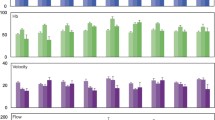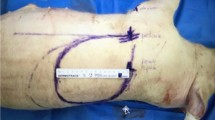Abstract
Introduction
The development of techniques in transplantation medicine—including various aspects—has made extraordinary progress within the past three decades. However, the transplantation of free tissue flaps with the common problem of limited ischemia time frames remains an area in which the understanding of mechanism during ischemia and reperfusion is still limited. Thus, similar to other organ transplantations, the prolongation of ischemic time and the possibility to perform an ex vivo perfusion is desirable. The purpose of this study was to create a closed and steady ex vivo perfusion system in order to analyze the possibility of using a miniaturized perfusion system for free muscle flaps that could also be clinically used for other solid organ transplantation.
Materials and methods
The rectus abdominis muscles of six german pigs were used in the study. Each of these free muscle flaps was perfused for a period of 2 h using a pulsatile and closed pump perfusion system by cannulating the arterial and venous vessels of the flap pedicle. During the ex vivo perfusion parameters such as arterial and venous pressures were measured continuously.
Results
A total of six ex vivo, closed and steady perfusions have been successfully performed. The optimal arterial flow rate of ex vivo perfusion of rectus abdominis muscle flaps was evaluated to be 10 ml/min. The constant measurement of arterial (46 ± 13 mmHg) and venous (−1 ± 1 mmHg) pressure in this ex vivo setting showed steady parameters during a period for up to 2 h.
Conclusion
The data of this study indicate that the ex vivo perfusion of free muscle flaps is technically feasible and a closed and steady circulation is manageable for a period of up to 2 h.





Similar content being viewed by others
References
Bastiaanse J, Nanhekhan LV, Slaaf DW, Boeckx WD, oude Egbrink MG (2006) Preservation of rat cremaster muscle microcirculation after prolonged cold storage and transplantation. J Surg Res 131:41–48
Bullocks J, Naik B, Lee E, Hollier L Jr (2006) Flow-through flaps: a review of current knowledge and a novel classification system. Microsurgery 26:439–449
Constantinescu MA, Knall E, Xu X, Kiermeir DM, Jenni H, Gygax E, Rieben R, Banic A, Vogelin E (2010) Preservation of amputated extremities by extracorporeal blood perfusion; a feasibility study in a porcine model. J Surg Res. doi:10.1016/j.jss.2010.01.040
Cypel M, Rubacha M, Yeung J, Hirayama S, Torbicki K, Madonik M, Fischer S, Hwang D, Pierre A, Waddell TK, de Perrot M, Liu M, Keshavjee S (2009) Normothermic ex vivo perfusion prevents lung injury compared to extended cold preservation for transplantation. Am J Transplant 9:2262–2269
Demiri EC, Hatzokos H, Dionyssiou D, Megalopoulos A, Pitoulias G, Papadimitriou D (2009) Single stage arteriovenous short saphenous loops in microsurgical reconstruction of the lower extremity. Arch Orthop Trauma Surg 129:521–524
Dorion D, Boyd JB, Pang CY (1991) Augmentation of transmidline skin perfusion and viability in transverse rectus abdominis myocutaneous (TRAM) flaps in the pig. Plast Reconstr Surg 88:642–649
Dragu A, Schnurer S, Surmann-Schmitt C, von der Mark K, Sturzl M, Unglaub F, Wolf MB, Leffler M, Beier JP, Kneser U, Horch RE (2010) Gene expression analysis of ischemia and reperfusion in human microsurgical free muscle tissue transfer. J Cell Mol Med, doi:10.1111/j.1582-4934.2010.01061.x
Dutta P, Hullett DA, Roenneburg DA, Torrealba JR, Sollinger HW, Harn DA, Burlingham WJ (2010) Lacto-N-fucopentaose III, a pentasaccharide, prolongs heart transplant survival. Transplantation 90:1071–1078
Francel TJ, Vander Kolk CA, Yaremchuk MJ (1992) Locally applied hypothermia and microvascular muscle flap transfers. Ann Plast Surg 28:246–251
Greaney PJ, Cordisco M, Rodriguez D, Newberger J, Legatt AD, Garfein ES (2010) Use of an extracorporeal membrane oxygenation circuit as a bridge to salvage a major upper-extremity replant in a critically ill patient. J Reconstr Microsurg 26:517–522
Haughey BH, Panje WR (1989) A porcine model for multiple musculocutaneous flaps. Laryngoscope 99:204–212
Kamelger F, Oehlbauer M, Piza-Katzer H, Meirer R (2010) Extracorporeal shock wave treatment in ischemic tissues: what is the appropriate number of shock wave impulses? J Reconstr Microsurg 26:117–121
Karaaltin MV, Erdem A, Canter I, Cavdar G, Baghaki S (2010) The bipedicled latissimus dorsi myocutaneous free flap: clinical experience with 53 patients. Microsurgery 30:179–184
Kivela JM, Raisanen-Sokolowski A, Pakarinen MP, Makisalo H, Jalanko H, Holmberg C, Lauronen J (2010) Long-term renal function in children after liver transplantation. Transplantation
Kuntscher MV, Hartmann B, Germann G (2005) Remote ischemic preconditioning of flaps: a review. Microsurgery 25:346–352
Lineaweaver W, Akdemir O, Schleich A (2010) Management strategies following microsurgical flap failure. Microsurgery 30:61–63
Maeda M, Fukui A, Tamai S, Mii Y, Miura S (1993) Extracorporeal circulation for tissue transplantation (in the case of venous flaps). Plast Reconstr Surg 91:113–124 (discussion 125-116)
Malinowski M, Pratschke J, Lock J, Neuhaus P, Stockmann M (2010) Effect of tacrolimus dosing on glucose metabolism in an experimental rat model. Ann Transplant 15:60–65
Rojas-Pena A, Reoma JL, Krause E, Boothman EL, Padiyar NP, Cook KE, Bartlett RH, Punch JD (2010) Extracorporeal support: improves donor renal graft function after cardiac death. Am J Transplant 10:1365–1374
Schottle P, Schmeling A, Romero J, Weiler A (2009) Anatomical reconstruction of the medial patellofemoral ligament using a free gracilis autograft. Arch Orthop Trauma Surg 129:305–309
Serafin D, Sabatier RE, Morris RL, Georgiade NG (1980) Reconstruction of the lower extremity with vascularized composite tissue: improved tissue survival and specific indications. Plast Reconstr Surg 66:230–241
Ulrich D, Fuchs P, Bozkurt A, Pallua N (2010) Free serratus anterior fascia flap for reconstruction of hand and finger defects. Arch Orthop Trauma Surg 130:217–222
Wang WZ, Fang XH, Stephenson LL, Khiabani KT, Zamboni WA (2008) Ischemia/reperfusion-induced necrosis and apoptosis in the cells isolated from rat skeletal muscle. J Orthop Res 26:351–356
Wong CH, Lin CH, Fu B, Fang JF (2009) Reconstruction of complex abdominal wall defects with free flaps: indications and clinical outcome. Plast Reconstr Surg 124:500–509
Yataco M, Bonatti H, Machicao V, Mendez J, Stauffer J, Nguyen J, Ghabril M, Aranda-Michel J, Dickson R (2010) Long term survival and complications after liver transplantation in patients with chronic hepatitis B. Ann Transplant 15:27–34
Acknowledgments
This work was supported by ELAN grant of the Friedrich-Alexander-University of Erlangen-Nürnberg (No. 09.10.06.1) and Xue Hong und Hans-Georg Geis Stiftung.
Author information
Authors and Affiliations
Corresponding author
Rights and permissions
About this article
Cite this article
Dragu, A., Birkholz, T., Kleinmann, J.A. et al. Extracorporeal perfusion of free muscle flaps in a porcine model using a miniaturized perfusion system. Arch Orthop Trauma Surg 131, 849–855 (2011). https://doi.org/10.1007/s00402-010-1251-8
Received:
Published:
Issue Date:
DOI: https://doi.org/10.1007/s00402-010-1251-8




